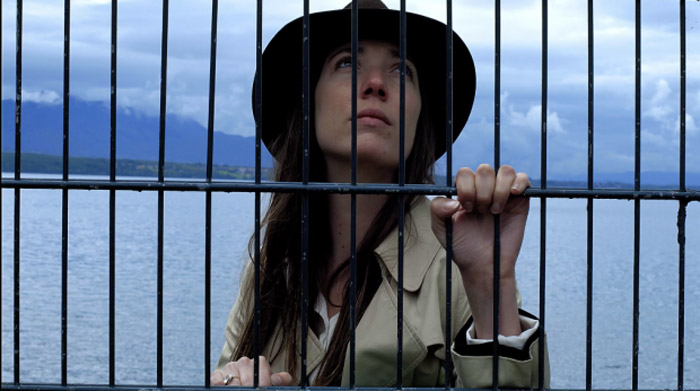Whereas other filmmakers have used 3D as a way to immerse us in their worlds, legendary director Jean-Luc Godard utilizes it to emphasize disconnect in his latest film, Goodbye to Language. While you can’t help but feel close to the dogs, flowers, and nude bodies that pop out at you, Godard simultaneously detaches us from the action onscreen through his use of unconventional shot angles, narrative fragmentation, and a plethora of different cinematographic styles. At the same time, the film is deeply naturalistic and cinema verite-like, thus forming a fascinating contrast.
The result is less a traditional narrative than a cinematic montage of thematically related ideas. Josette (Héloise Godet) and Gédéon (Kamel Abdeli) are a pair of lovers who discuss the tenuous nature of their relationship (she’s married to someone else and he’s single) and muse on life in often compromising situations. As he sits on the toilet while she stands naked in front of him—which happens frequently throughout the film—Godard grants the audience a voyeuristic look at the relationship, which the 3D serves to exaggerate.
At the same time, we don’t learn much about this pair, due to the frequent cuts to other vignettes and images: A dog travels between town and country, seemingly unsure of his proper home; a couple prepares for their international travel on a cruise ship. Documentary footage is interspersed throughout, as various voice-overs explain details about Hitler’s rise to power and other historical events. The music of composers ranging from Beethoven to Sibelius fades in and out throughout these sequences, and the shots fall on a wide spectrum between hyperrealistic and deeply Impressionist.
Naturally, this chaotic approach doesn’t yield much in the way of narrative continuity, but that doesn’t seem to be what Godard is going for here. Rather, the film is about the feeling of existence—you can’t hope to understand what’s going on, but you grasp the emotions that are being conveyed. This works particularly well in the handheld, digital video-like segments, which effectively mimic the folksy appeal of home movies. The use of 3D accentuates realism without undermining it through the inherent flashiness of the added dimension.
Goodbye to Language showcases a unique approach to 3D filmmaking, and one that more directors, hopefully, will have the courage—and funding—to attempt. While films like Gravity and Avatar use the technique to place audience in wholly unfamiliar situations, Godard adopts it strictly in the realm of the everyday. However, the discontinuity throughout the film’s 70-minute running time makes the mundane settings feel bizarre and obtuse. Everything onscreen is recognizable, but rendered foreign thanks to Godard’s constant juxtapositions. Goodbye to Language dramatizes the feeling of our increasingly paradoxical relationship with each other in the contemporary world—though we are closer than ever to each other thanks to the ties of technology, the digital world simultaneously alienates and isolates us. This makes for uncomfortable viewing, but an experience well worth having.
Goodbye to Language runs until Oct. 30 at 8 p.m. at Cinema du Parc (3575 Parc). Student tickets are $10.









